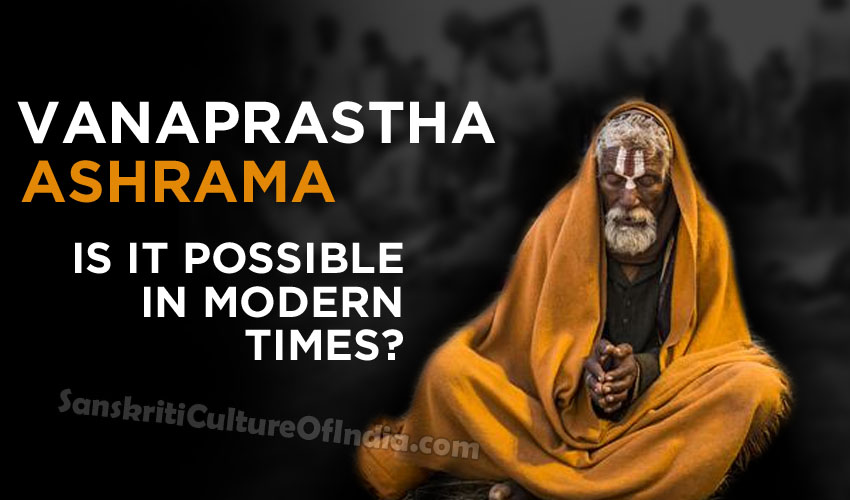In ancient India, a person’s activities were harmoniously regulated according to his or her stage of life. Each stage had its own dharma, or duties, to be undertaken. These stages, called Ashramas, were four in number—Brahmacharya, Grihastha, Vanaprastha, and Sannyasa—and were to be strictly followed. The ashrama system was fundamental to maintaining discipline, peace, and harmony in the family and society. In family as well as social and public arenas, virtuous living, guided by noble character, high values, and a sense of duty, was the norm, resulting in all round happiness, peace, and harmony. But with the passage of time the meaning, interpretation, and practical application of the ashrama system changed, and gradually the whole system fell into disuse.
 The Ashrama System
The Ashrama System
The guidelines for an ideal arya-jivana, or life of an Arya, have been delineated in Manu Samhita, Bhrigu’s codification in verse of rules laid down by the ancient Indian lawgiver Manu. Manu clearly explains the significance of and duties pertaining to the four ashramas. Though Manu and the Manu Samhita have not escaped modern controversy, still, his work is a foundational Dharmashastra, and forms the basis of Hindu law even today. The four ashramas are described below:
The Brahmacharya Ashrama was meant for the all-round development of the child, including formal, informal, and secular education. One was to receive training in various areas to enable one to stand on one’s own feet in later life. Ethics and values were imbibed in each and every area of learning. Manu set forth the many basic traits which were to be developed from student days. For example, the following two shlokas from Manu Samhita illustrate the most important virtues to dev eloped in young age:
Indriyanam vicaratam visayesvapaharisu;
Samyame yatnam-atisthed-vidvan-yanteva vajinam.
The wise person (brahmacharin) should strive to restrain his senses which run wild among alluring sense objects, just as a charioteer controls his horses (2.88).
Vase krtvendriyagramam samyamya ca manastatha;
Sarvan-samsadhayed-arthan-
Having subdued the (ten) organs and controlled the mind, one (brahmacharin) should achieve all one’s aims without weakening the body through yoga (excessive austerity) (2.100).
In the Grihastha Ashrama, the householder was to discharge all his duties and debts according to dharma. Artha, wealth, was to be obtained for satisfying kama, desire, but only in a righteous manner, according to dharma. Enjoying worldly life, earning money, having children, taking care of the family and its welfare, and performing various duties required by family and society: these belong to this stage of life. Manu called the Grihastha Ashrama the key to the other three:
Yatha vayum samasritya vartante sarvajantavah;
Tatha grhastham-asritya vartante sarva asramah.
As all creatures depend on air for life, in the same way (the members of) all ashramas subsist on the support of the grihastha (3.77). It is important to note here that if a grihastha does not live in the prescribed way, the other three ashramas are affected. Manu continues:
Yaman-seveta satatam na nityam niyaman-kevalan-bhajan.
Yaman-pataty-akurvano-niyaman-
A wise man should constantly discharge the paramount duties (called yama), but not always the minor ones (called niyama); for he who does not discharge the former, while he obeys the latter alone (surely) falls (4.204). In other words, first the yamas, then the niyamas. What are they? These shlokas explain:
Anrsamisyain ksama satyam-ahimsa damam-asprha;
Dhayanam prasado madhuryam-arjavam cayama dasa.
Mercy, forgiveness, truth, non-violence, control over the senses, non-attachment, concentration, joyousness, sweetness, and straightforwardness are the ten yamas.
Saucam-ijya-tapo-danam svadhyayopasthanigrahah; Vratopavasau maunam ca snanam ca niyama dasa.
Purity, sacrifice, austerity, charity, study, chastity, pious observances, fasting, control of speech are thenniyasmas.
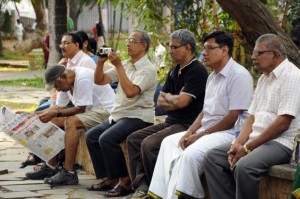 The Vanaprastha Ashrama was to be entered household duties completed, and one’s settled. One was to hand the household over to one’s successor, leave the worldly life and all its luxuries and enjoyments and go to the vana, the forest, to lead a sattvic, godward life in solitude. The Manu Samhita says:
The Vanaprastha Ashrama was to be entered household duties completed, and one’s settled. One was to hand the household over to one’s successor, leave the worldly life and all its luxuries and enjoyments and go to the vana, the forest, to lead a sattvic, godward life in solitude. The Manu Samhita says:
Grhasthastu yada pasyed vali palitam atmanah; Apatyasyaiva capatyam tadaranyam samasrayet.
When a householder gets to see wrinkles on his body, white hair on his head, and his grandchildren, he should resort to the forest (6.2)
Svadhyaye nityayuktah syad danto maitrah samahitah; Datta nityam-anadata sarvabhutanukampakah.
He should be engaged in regular study, control his senses, keep friendly behavior with everyone, and have a tranquil mind. He must always give in charity, not accept gifts from others, and have mercy on all living beings (6.8).
The Sannyasa Ashrama was the final stage of life, in which one was to give up everything and strive solely for liberation through intense sadhana. The aim was to reach the final goal of human life, moksha or liberation from samsara-or God-realization.
Vanesu tu vihrtyaivam trtiyam bhagam-ayusah; Caturtham-ayuso bjagam tyaktva sangan-parivrajet.
After spending the third portion of one’s life in the forest, the fourth portion of life should be spent as a sannyasin, renouncing all attachment (for the world) (6.33).
Adhyatma-ratir-asino nirapekso nir-amisah; Atmanaiva sahayena sukharthi vicared-iha.
Delighting in meditation on the Supreme, independence of others, giving up all desires, with only the Self as companion, seeking supreme bliss, shall (the sanyasin) live (6.49).
At the present time, these ideals as given by Manu are not practical or applicable in toto. However, they embody certain basic truths and values which are not only applicable but also very much wanted to re-establish the glory of India.
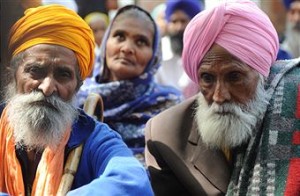 Current State of the Elderly
Current State of the Elderly
Nowadays, most people live a very hectic life. Their lifestyle, priorities, need for luxury and enjoyment, and often, lack of values, leave no room for the concept of ashramas. Some strive for great wealth, name and fame. The majority, perhaps, are just trying to earn their bread, trying to live the best possible life. And there are many unfortunate people whose condition is so miserable that they cannot think beyond having two meals per day. For these last, the four ashramas have absolutely no meaning at all.
When those who have striven for wealth, name, and fame, and those who have lived a life of relative comfort, retire from active life, they—some of them at least—feel emptiness. Their worldly achievements no longer seem attractive. They feel a strong craving for peace and true joy. Most of these people have enjoyed enough worldly life and public life; they have fulfilled their duties towards family and society. However, they feel emptiness within.
How do they address this emptiness? Those having spiritual aspiration from their youth may try to get involved in activities with their chosen organization, where their spiritual quest can flourish. When such activities are performed without attachment the aspirant will gain true joy and fulfillment. Some try to use their knowledge and experience in activities benefiting society at large, without seeking personal gain. Such selfless work will give them inner joy and fulfillment. Those who are well-to do, having adequate finances and shelter and good health, have the freedom to live their life in their own way, and may try to find joy and peace by engaging themselves in activities of their choice, like traveling, socializing with their friends, or spending occasional quality time in solitude. Such people will also find inner joy and fulfillment. Yet others will choose to spend lots of time in reading, writing, researching, creating new things, painting, music, dancing, and other art-related activities and find joy and fulfillment in those things.
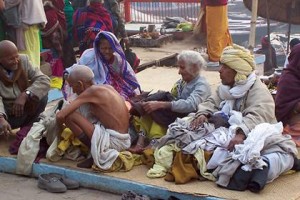 There are many families in which the retired members are well-respected, well-treated, and very lovingly taken care of as long as they live. Such families have strong family bonds. Moreover, their family legacy is carried forward from generation to generation. In such cases there is nothing to worry about.
There are many families in which the retired members are well-respected, well-treated, and very lovingly taken care of as long as they live. Such families have strong family bonds. Moreover, their family legacy is carried forward from generation to generation. In such cases there is nothing to worry about.
But the avenues of expression and seeking fulfillment we have mentioned are not available to all; a large number of people are stymied in their search for inner joy and happiness in their retired life. A typical family set-up, which has naturally many distractions, makes such a search difficult. Again, many may be unable to live in solitude because of poor health, financial constraints, or the fear of social stigma. Most elderly people are dependant upon others—either children or someone close. Very few people have the freedom and provisions to live independently in their own way. Even if they do, it may not be safe for them to do so. Elderly persons living alone are easy targets for criminals, and cases of such people being robbed and even murdered in their own homes are increasing, particularly in the metropolises.
Under such circumstances, most elderly people compromise with the conditions they are confronted with. Some end up living in old-age homes; some with severe health problems are kept in nursing homes. Again, there are old people who are so much attached to their family life—even in old age—that they cannot imagine living in any other way but with the family. Some are attached to their wealth; some are attached to their children and grandchildren. Even if there are problems and an unhappy environment in the family, they try to adjust, and try to feel contented living in the same old ruts. Nobody can help such people suffering and living an unhappy life. This is certainly not the way to live in one’s old age!
Seeking Solutions
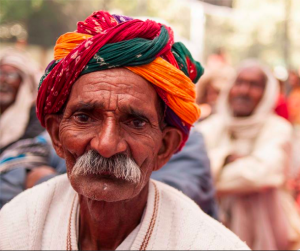 What is the reason for the poor living conditions of elderly people in Indian society at large? Are we under the strong influence of Western culture—where parents are often remembered only on special days like Mother’s and Father’s Day and birthdays! Have we totally forgotten out culture? Have we failed to raise our children properly? Have we failed to be effective role models for our children?
What is the reason for the poor living conditions of elderly people in Indian society at large? Are we under the strong influence of Western culture—where parents are often remembered only on special days like Mother’s and Father’s Day and birthdays! Have we totally forgotten out culture? Have we failed to raise our children properly? Have we failed to be effective role models for our children?
There are many reasons, some legitimate and some not. Primary among them is that the first two ashramas of life, Brahmacharya and Grihastha, are not followed properly in today’s society. Without the strong foundation of the first two ashamas we cannot expect the second two to be healthy, as in days of yore. Though at present it is neither possible nor practical to go back, as it were, to the ancient ashrama system, we can make efforts to bring the ashrama system into modern society, adapting it to suit, in the best possible way, the present generation.
With globalization, the thinking, lifestyles, value systems, and culture of Indians are in transition as they are for almost all nations. However, Indians have inherited certain basic values which will protect them from succumbing fully and irreversibly to Western culture. Many institutions, ashramas, and gurukulas have been established and are working for positive change, working towards making ethical, disciplined, intelligent, goal-oriented, and value-holding citizens for tomorrow. The results of these efforts will be seen in the next twenty to twenty five years, and at first in small numbers. Efforts in this direction must be increased and strengthened, to prepare the youth to be enlightened citizens of India. Time will reveal the impact of these efforts.
Community-living for the Elderly
What can be done today? The quandary here is of a large number of people seeking a happy, peaceful, and enjoyable life of their choice in old age. Old-age homes and nursing homes are not the right places for such people. What is the right place? One right place’ can be found in the concept of community living for the elderly. In old-age homes, the residents are just passing their time, living monotonous lives in loneliness, without any aspiration or enthusiasm, and simply waiting for death.
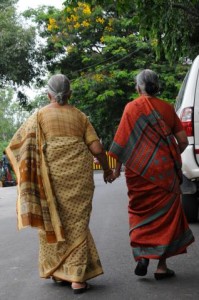 ‘Community living for the elderly’ has a wholly different set-up. It provides all facilities for leading a fulfilling retired life: basic necessities like housing, food, water, electricity health care, and security, and extras like housekeeping, a library, walking-cum-fogging trails, a gymnasium, a toga centre, indoor-outdoor games, and an entertainment centre. It can also provide special cells or cubicles for people interested in solitude and meditation. Everything is available in the same campus or complex. Relatives, friends, and well-wishers can come to visit, if they wish at prescribed times. The residents can also go to visit their loved ones, if they so desire. This type of community living can provide a hassle-free, safe, enjoyable life to elderly people, without their becoming a burden or liability to anybody. They can live with self-respect and spend their time in their own way. They might get involved in any indoor-outdoor activity of their choice, or just relax, read, meditate, and spend more time in spiritual pursuits. They can find like-minded people in the same complex with whom they can share their pleasure and pain, and their activities. Most important is that their safety is ensured. In such a complex the residents have their private lives, with the benefits of group living, and full security.
‘Community living for the elderly’ has a wholly different set-up. It provides all facilities for leading a fulfilling retired life: basic necessities like housing, food, water, electricity health care, and security, and extras like housekeeping, a library, walking-cum-fogging trails, a gymnasium, a toga centre, indoor-outdoor games, and an entertainment centre. It can also provide special cells or cubicles for people interested in solitude and meditation. Everything is available in the same campus or complex. Relatives, friends, and well-wishers can come to visit, if they wish at prescribed times. The residents can also go to visit their loved ones, if they so desire. This type of community living can provide a hassle-free, safe, enjoyable life to elderly people, without their becoming a burden or liability to anybody. They can live with self-respect and spend their time in their own way. They might get involved in any indoor-outdoor activity of their choice, or just relax, read, meditate, and spend more time in spiritual pursuits. They can find like-minded people in the same complex with whom they can share their pleasure and pain, and their activities. Most important is that their safety is ensured. In such a complex the residents have their private lives, with the benefits of group living, and full security.
Looking to the practical side, there can be different categories and options within such a complex, tailored to meet people of varying financial resources and desired lifestyles. Just as people make provisions for their retired life ahead of time, they may start saving for the community living of their choice from a young age. When they reach retirement age, they do not have to worry about resources. Nobody knows about tomorrow, so it is wise to think ahead of time.
This whole concept sounds Utopian at first—but it is not so. Plans for implementing ‘community living for the elderly’ are under serious consideration in Australia and some European countries, where they are expecting a heavy rise in the population of elderly people in the coming decade. The baby boom generation of 1940’s and 50’s will soon become senior citizens. These countries are planning the welfare of their retired people quite ahead of time. Of course, in India the situation is exactly the other way round at present: the major portion of our country’s population in the coming years will be young people. However, the needs and welfare of the present generation of elderly people in India must be seriously addressed. If this concept can be successfully worked out now, it will help the country when the young generation of today reaches that stage. Such plants should be worked out well in advance thus benefiting the present generation of elderly people as well serving the cause of future generations.
Now, who will implement this is the million dollar question. But: ‘Where there’s a will, there’s a way’. There are many ways to materialize the plan. The government, social work agencies, non-government organizations, or even dedicated individuals can investigate and analyse this concept, and endeavour to make it possible and practical. Nothing is impossible if there is a strong will. A recent news item reported a proposal to build such a complex for non-resident Indians (NRIS)! So why not for resident Indians? This is a need of the hour.
‘Community living for the elderly is an idea whose time has come. It will become the Vanaprastha Ashrama for many people in the present age. The sooner it can materialize, the better—for the present as well as future generations.’
~ By Dr. Pratima D Desai
Copyright Prabuddha Bharata

